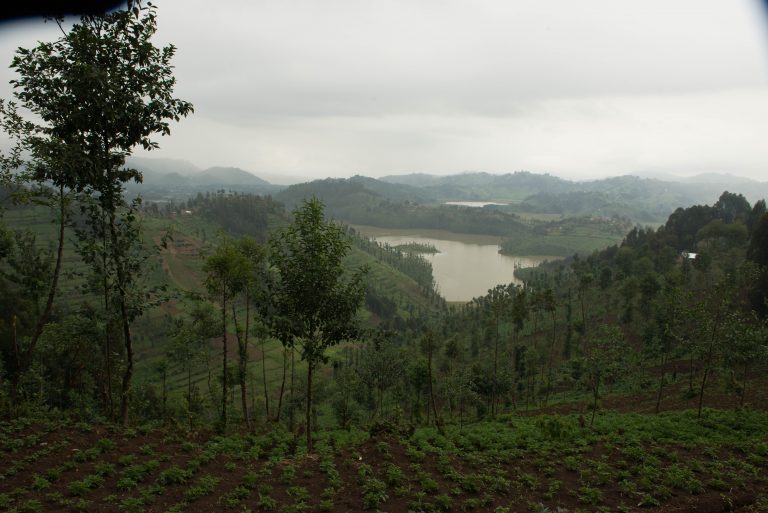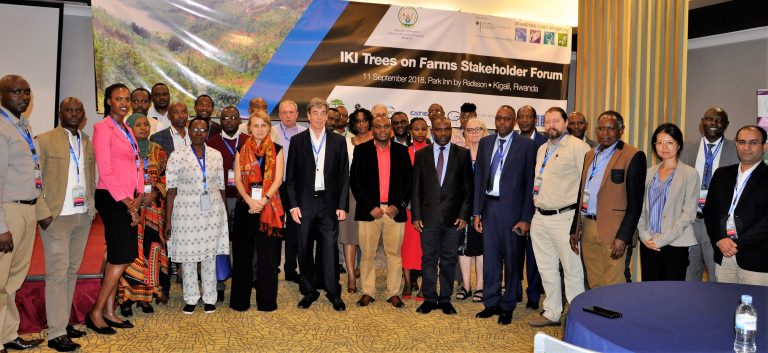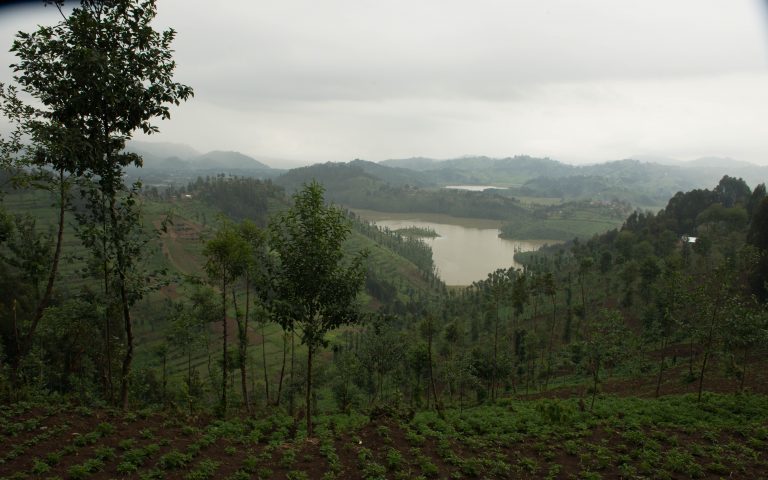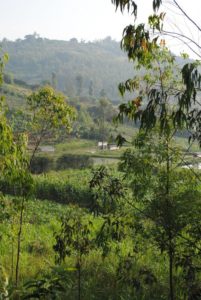
Rwanda will use agroforestry to meet its targets for land restoration and enhancement of biodiversity
The Government of Rwanda is setting out to increase national tree cover by 30% and to restore 2 million hectares of degraded land to fulfil its commitments to the national Vision 2020, Bonn Challenge and African Forest Landscape Restoration Initiative. Owing to the country’s limited land area, 85% of this restored tree cover will be through integration of more trees into farming systems, that is, agroforestry. This commitment, along with other land restoration and conservation initiatives already underway, will help Rwanda reach its ambitious targets, supported by a new project.
Harnessing the Potential of Trees on Farms for Meeting National and Global Biodiversity Targets (Trees on Farms for Biodiversity) is led by the World Agroforestry Centre (ICRAF) and the International Union for Conservation of Nature. It is implemented not only in Rwanda but also Honduras, Indonesia, Peru and Uganda. It is supported by Germany’s International Climate Initiative of the Federal Ministry for the Environment, Nature Conservation and Nuclear Safety.
“We recognize the global importance of our forests and understand our obligations as citizens of the world to sustainably manage resources,” said Jean Claude Musabyimana, Permanent Secretary of Rwanda’s Ministry of Lands and Forestry. “Our latest National Forestry Policy links our forest conservation operations to the Paris climate change agreement, Bonn Challenge and other international and regional conventions. Trees on farms contribute to the preservation of biodiversity.”

Natural forests in Rwanda are protected for the purposes of maintaining biodiversity, mitigating climate change and as a source of income through tourism.
However, acknowledging that protected areas alone are inadequate for preventing biodiversity loss, Trees on Farms for Biodiversity will contribute to Rwanda’s National Biodiversity Strategy and Action Plan, which builds on the country’s commitment to Aichi Target 7 of the United Nations Convention on Biodiversity: the sustainable management of agriculture, aquaculture and forestry, ensuring conservation of biodiversity.
“The concept of trees on farms to improve biodiversity has not received much attention,” said Prime Ngabonziza, director-general of the Rwanda Water and Forestry Authority. “It is worthwhile to consider how trees on farms improve biodiversity, provide economic benefits and increase soil fertility, pollination and other ecosystem services.”
As in many other developing countries, Rwanda’s agriculture is the biggest driver of deforestation. According to the Natural Resources Authority, from 2008/09 to 2013/14 the area of productive forests shrank from about 285,000 to around 258,000 hectares through conversion to agroforestry and agriculture. Shrubland, including wooded savannah, diminished from about 192,000 hectares to an estimated 143,000 hectares through conversion to agroforestry and agriculture. To put it another way: agricultural land increased from 1,460,000 to around 1,503,000 hectares through conversion of productive forests and shrubland. The establishment of new settlements and mining activities are also hindering the Government’s efforts to protect biodiversity.
“Biodiversity will suffer unless measures are put in place, simply because agriculture accounts for more than 60% of Rwanda’s economy,” said Charles Karangwa, IUCN’s regional coordinator of the Forest Landscape and Livelihoods Programme. “We must invest in innovative research to understand trees-on-farms uptake by smallholders. We recognize that farmers want to plant fast-growing exotic tree species for fuel. We must balance between those and indigenous species to meet farmers’ needs.”
Agroforestry, the practice of integrating trees with crops and livestock, provides products and services vital for improving livelihoods and ecosystems, such as more diverse and plentiful food, timber and fuelwood and improved soil and water conditions. Agroforestry systems are inherently more diverse than monocultural crop systems, automatically helping to increase biodiversity.
“Rwanda’s landscape was traditionally defined by the co-existence of the four elements of people, crops, livestock and trees,” said Athanase Mukuralinda, ICRAF’s Rwanda representative. “Problems started when people started cutting down trees. The Trees on Farms for Biodiversity project will help to bring back trees to restore the landscape.”
“The Trees on Farms project will increase our knowledge of the links between trees, agriculture and biodiversity,” said Anja Gassner, the project leader. “We will develop a biodiversity assessment tool to measure the contribution of trees on farms to biodiversity and sustainability.”
Following the stakeholder forum, the Rwanda Ministry of Lands and Forestry, IUCN and ICRAF convened a high-level panel of delegates from different sectors to chart a path towards improved cross-sectoral collaboration on designing sustainable ways to ‘green’ Rwanda.
“Rwanda has made its commitments towards land restoration,” said Phil Dobie, the project’s senior advisor. “It has also made a commitment to transformational development. Trees on Farms for Biodiversity extends the restoration agenda to farms, protects biodiversity, and contributes to a green economy through agriculture.”




